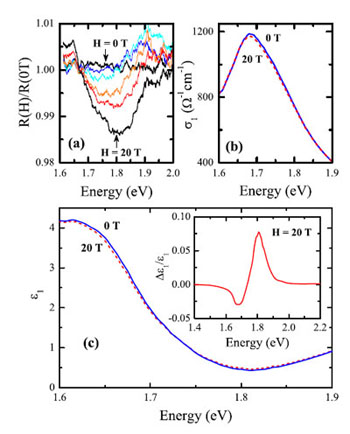Spin-Charge
Coupling and the High-Energy Magnetodielectric Effect
in Hexagonal HoMnO3
The hexagonal HoMnO3 is multiferroic.
Ferroelectric and antiferromagnetic orders coexist below
the Néel temperature (TN~75 K), where
Mn3+ spins order antiferromagnetically. Ferroelectric
transition temperature is TFE~900 K and the
ferroelectric moment along the c axis in this phase is
due to Ho-O displacements. This material displays a rich
H-T phase diagram. At least six different magnetic phases
have been reported. We investigated the optical and magneto-optical
properties of HoMnO3 in order to elucidate
the spin-charge coupling and high-energy
magnetodielectric effect.

(a) Optical conductivity of HoMnO3 at 300
and 6 K extracted from the measured reflectance by a
Kramers-Kronig analysis. The inset shows a typical peak
fit of the Mn d to d excitations at 6 K. We find that
the Mn d to d excitations are sensitive to the cascade
of low-temperature magnetic transitions involving the
Mn3+ moment, direct evidence for spin-charge
coupling. An applied magnetic field also modifies the
Mn d to d on-site excitations.
(b) Peak positions of model oscillators, fitted to
the on-site excitations, as a function of temperature.
The shaded vertical lines designate the well-known TN
(antiferromagnetic) and TSR (spin reorientation)
transitions.
The high-energy dielectric contrast of HoMnO3
in the region of the Mn d to d excitations around TN
and TSR transitions.
Based on the position of these features, the dielectric
contrast in HoMnO3 is associated with dispersive changes
in the Mn d to d on-site excitations, with the highest-energy
dxz to d(3z2-r2) and
dyz to d(3z2-r2) excitations
being most strongly affected. We therefore see that
the spin-charge coupling depends on symmetry.
(a) The 6 K normalized magneto-optical
response of HoMnO3, R(H) /R(H=0 T), in an applied magnetic
field from 0 to 20 T H ||c. Data are shown in 4 T steps.
(b) Optical conductivity for H=0 (solid line) and 20
T (dashed line) at 6 K.
(c) Dielectric response for H=0 (Blue) and
20 T (Red) (H||c) at 6 K. The inset shows a close-up
view of the high-energy dielectric contrast, which is
the largest in the region of the Mn d to d excitations.


Conculsion: We find that
the Mn d to d excitations are sensitive to the cascade
of low-temperature magnetic transitions involving the
Mn3+ moment. This is because the local environment
around the Mn3+ center is subtly modified at
TN and TSR. This sensitivity provides
direct evidence of spin-charge coupling. Field-induced
optical property modifications are observed in the region
of the Mn d to d excitations. We find that the high-energy
magnetodielectric contrast in HoMnO3 is ~8%
at 20 T near 1.8 eV, similar in magnitude to that in the
frustrated Kagomé lattice compound Ni3V2O8
(16% at 30 T near 1.3 eV) and the mixed-valent magnetic
oxide K2V3O8 (5% at 30
T near 1.2 eV). The magnetodielectric contrast in HoMnO3
can be positive or negative depending on the energy. The
high-energy magnetodielectric contrast derives from the
substantial mixing in this multiferroic system.
Reference: R. C. Rai et al., Phy.
Rev. B 75, 184414 (2007)
Top


